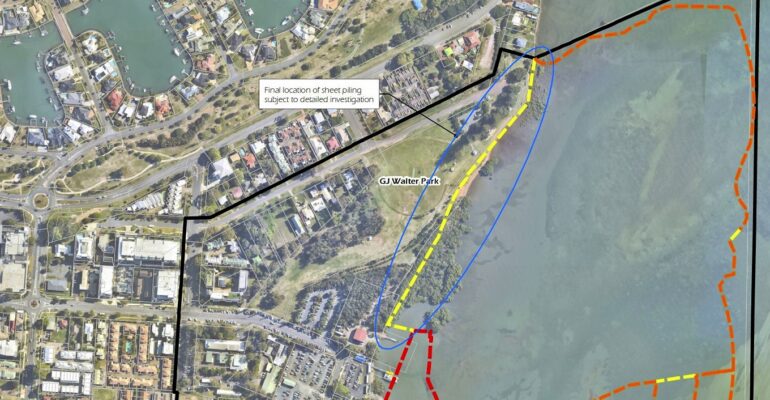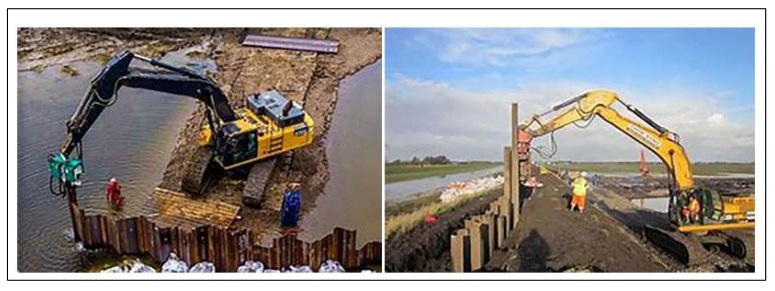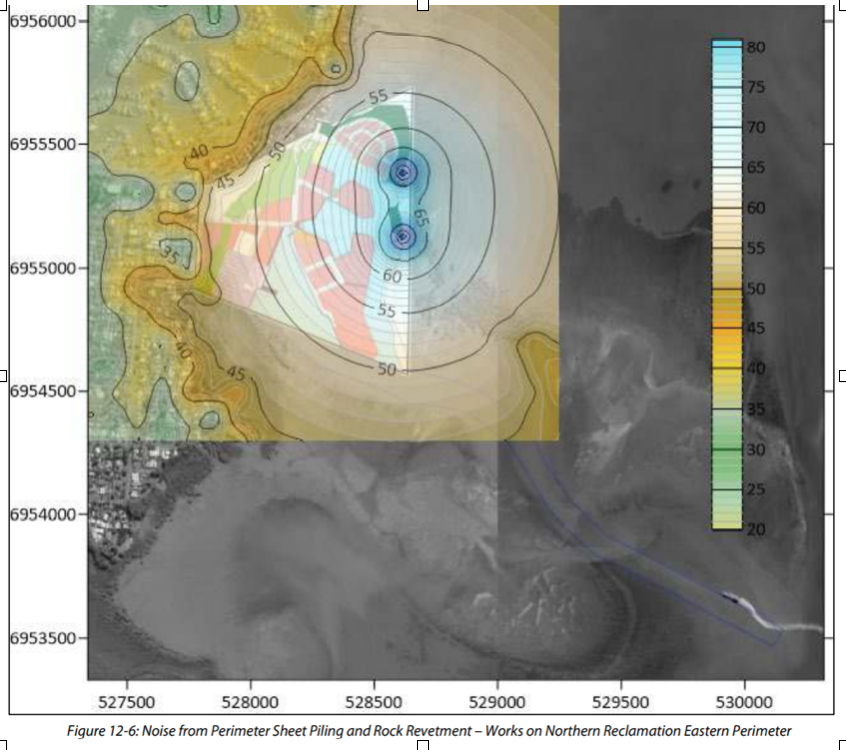
Extract from Figure 2-23: Reclamation Perimeter Bund Final Edge Treatments in Draft EIS
Careful scrutiny of the Toondah Harbour Draft EIS reveals disturbing impacts that East Cleveland residents will have to endure from many months of noise from sheet piling.
The massive scope of construction – noise, traffic, vibrations, dredging, and earthwork characteristics combined with decades-long duration of site works risks not only an erosion in residents’ quality of life but a destructive effect on residential property values throughout the twenty year life of the project.
Early stage works involve sheet piling
One such substantial impact warranting attention, occurs in the very early-stage commencement of works. The installation of sheet-piling to construct the Stage 1 containment bund.
The containment bund serves as a linked steel wall structure defining the reclaimed area, preventing ingress of water from the Bay, whilst water retained internally to the bund is extracted and site is excavated and filled with dried and treated in-situ and imported dredge spoil to form the compacted earth foundation for the proposed Stage 1 landforms.
Firstly, the method of sheet piling installation proposed by the proponent is by means of excavator-attached vibration hammer. This video illustrates this equipment and process.

from the Toondah Harbour Draft EIS Chapter 2 page 2-51 Plate 2-12
Impacts from installing sheet piling
It is clearly a slow, painstaking and above all aggravatingly noisy process. The Draft EIS rates a vibration hammer terrestrial noise level at 112 Decibels (jackhammer equivalent). Section 12.4 of the EIS (Noise Impacts) states, sheet piling at the easternmost point of Stage 1 bund to Cassim Island “the distance from [vibration operations] to the 50 dB(A) noise contour is 650m” – with 50dB(A) rated the volume of human conversation.
An example of noise modelling for sheet piling, in the Draft EIS, is shown below.

from the Toondah Harbour Draft EIS Chapter 12 Terrestrial and Underwater Noise Vibration page 12-16
Notably from this chart, audibility contours from this ‘easternmost’ piling point show pneumatic hammer vibration sound radiating northward and westward into Cleveland and Raby Bay suburbs (as per the yellowed shading).
However, extensive vibration sheet piling also takes place on the north, south and western shoreline (G.J. Walker Park) bund-perimeters of Stage 1, putting the epicenter of vibration noise closer to (and at) the shoreline, and bringing other residential areas into scope.
Unfortunately, and perhaps not unsurprisingly, noise modeling maps are not provided for sheet-piling at these locations. One may get a general idea of how nearby locations will experience increased sound levels, and of the broader suburban footprint of noise dispersion, by visually superimposing the chart-contours over these locations.
Many months of sheet piling noise
Now consider, an extract from the Draft EIS Appendix 1-I:
“The estimated rate of installation of the sheet pile wall would be approximately 12m linear metres per day. The total length of sheet pile wall for Stage 1 would be approximately 2,000m and for Stage 2 would be approximately 1,200m. Hence the durations of installation of the sheet piling for Stage 1 and Stage 2 would be approximately 30 weeks and 20 weeks respectively … “
So, sheet-piling installation by vibration hammer for stage 1 will need to operate on each site-work day for 30 weeks – that’s over 7 months, or 60% of an entire year!
This predicted noise level impact is stated in the Draft EIS to meet noise level goals of the Environmental Protection Act 1994, represented in Table 12.2 of Chapter 12 as sub 60 dB(A) for Daytime operating periods for relevant durations of >2 weeks and < 6 months, and > 6 months.
Whilst the residential impact of sub 60 dB construction sound levels is considered a manageable aspect of the Draft EIS, what isn’t accounted for (estimated at 45+ dB) is the constant ambient background hammering noise generated during daytime construction hours, that residents will have to endure every working day for 6 months.
The mental health effects of this situation cannot be overstated.
And once Stage 2 starts in 5 years, its back on again for another 5 months straight.
Piling for construction of buildings
The sheet piling discussed above would create the new land for construction of buildings which could be up to ten storeys.
We have yet to find in the Draft EIS a clear account of the noise that will be generated from building works, which could include hammer piling.
Winners and losers
The sheet piling is being done to benefit Walker Group who stand to make hundreds of millions from creation of new land out of publicly owned Marine Park wetlands.
The losers would be East Cleveland residents exposed to many months of noise disturbance.
And that’s even before considering the consequences of underwater sound-pressure waves from 2 kilometres of sheet-piling vibration radiating into Moreton Bay Marine Park, disturbing underwater wildlife with sensitive sound receptors.
The likely impacts on marine life are not explored in the Draft EIS.
Editor’s note
Redlands2030 acknowledges the contribution of a community member who assisted greatly in the production of this story.
More about the Draft EIS
Here are some other stories about the Draft EIS, published by Redlands2030:
Unboxing the Toondah Harbour Draft EIS
Toondah koalas endangered by Walker Group’s proposed apartments project
Who wants a bigger ferry channel at Toondah Harbour?
Fatal flaw in Toondah Harbour real estate scheme – by Richard Carew
Paying it Forward – by Ian Victor
Toondah EIS fails the test – by Howard Guille
Half-baked EIS sells out protected Toondah Harbour – by Steve Bishop
Redlands2030 – 22 November 2022
Please note: Offensive or off-topic comments will be deleted. If offended by any published comment please email thereporter@redlands2030.net
2 Comments
Out of all the coastline of Australia they want to destroy an existing eco system which is well established instead of uninhabited parts of the coast which bother no local people or wildlife. Obviously none of these people care about money and not the environment or local peoples lives which there hard earned money bought there little piece of paradise away from people and developers like you
We moved to Cleveland from Sydney for a quiet retirement. When we built this house there no mention of development at Toondah Harbour. It seems this development not only has no thought for the wildlife and wetlands but totally ignores the residents.